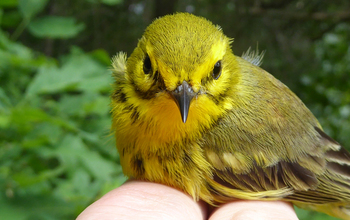Multimedia Gallery
Female prairie warbler
A female prairie warbler (Setophaga discolor) at the Bent of the River Audubon Sanctuary in Southbury, Connecticut. A study that tracked biodiversity in nesting birds found that insectivorous birds like the prairie warbler showed the most drastic declines across all geographic scales, from local to continental.
More about this image
Researchers at Yale University studied 50 years of data about nesting birds in North America and tracked biodiversity changes on a local, regional and continental scale. They found significant differences in how much change had occurred, based upon how wide a geographic net they cast.
The findings have implications for how to assess biodiversity in a rapidly changing world, as well as how biodiversity information should be presented.
"Biodiversity is changing all around us and worldwide. Local species disappear and sometimes other species invade," said co-author Walter Jetz, professor of ecology and evolutionary biology and co-director of the Max Planck-Yale Center for Biodiversity Movement and Global Change. "Studying birds in the U.S. and worldwide, we show that patterns and implications of this ongoing change vary strongly with the scale."
This means a minor loss or gain of species richness or functional diversity at the local or county level can look like a major gain at the state or national level, and yet be a net loss when viewed at a global scale.
This work has been supported by the National Science Foundation (NSF) Genealogy of Life (GoLife) program (grants DEB 15-41557, DBI 12-62600 and DEB 14-41737), of which the main goal is to understand the multiple dimensions of biodiversity.
To learn more about this research, see the UA Fairbanks news story Scale is a key ingredient when tracking biodiversity, researchers say. (Date image taken: June 7, 2018; date originally posted to NSF Multimedia Gallery: Dec. 17, 2018)
Credit: Julie Hart, Yale University
Images and other media in the National Science Foundation Multimedia Gallery are available for use in print and electronic material by NSF employees, members of the media, university staff, teachers and the general public. All media in the gallery are intended for personal, educational and nonprofit/non-commercial use only.
Images credited to the National Science Foundation, a federal agency, are in the public domain. The images were created by employees of the United States Government as part of their official duties or prepared by contractors as "works for hire" for NSF. You may freely use NSF-credited images and, at your discretion, credit NSF with a "Courtesy: National Science Foundation" notation.
Additional information about general usage can be found in Conditions.
Also Available:
Download the high-resolution JPG version of the image. (3.3 MB)
Use your mouse to right-click (Mac users may need to Ctrl-click) the link above and choose the option that will save the file or target to your computer.



